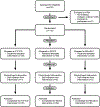Weight Loss Interventions for Adolescents With Intellectual Disabilities: An RCT
- PMID: 34413247
- PMCID: PMC8477713
- DOI: 10.1542/peds.2021-050261
Weight Loss Interventions for Adolescents With Intellectual Disabilities: An RCT
Abstract
Objectives: In this randomized trial, we compared the effectiveness of 2 diets (enhanced stop light diet [eSLD] versus conventional meal plan diet [CD]) and 2 delivery strategies (face-to-face [FTF] versus remote delivery [RD]) on weight loss across 6 months in adolescents with intellectual and developmental disabilities who were overweight or obese.
Methods: Participants were randomly assigned to 1 of 3 arms (FTF/CD, RD/CD, or RD/eSLD) and asked to attend one-on-one sessions with a health educator every 2 weeks to aid in maintaining compliance with recommendations for a reduced-energy diet and increased physical activity. The CD followed the US dietary guidelines. The eSLD used the stop light guide and was enhanced with portion-controlled meals. The FTF arm was delivered during in-person home visits. The RD arms were delivered by using video conferencing.
Results: A total of 110 adolescents with intellectual and developmental disabilities (aged ∼16 years, 53% female, BMI 33) were randomly assigned to the FTF/CD (n = 36), RD/CD (n = 39), or RD/eSLD (n = 35) group. Body weight at 6 months was obtained from 97%, 100%, and 86% of participants in the FTF/CD, RD/CD, and RD/eSLD arms, respectively. The eSLD elicited significantly greater weight loss than the CD: RD/eSLD (-5.0 ± 5.9 kg; -6.4%) versus RD/CD (-1.8 ± 4.0 kg; -2.4%) (P = .01). However, weight loss did not differ by delivery strategy: FTF/CD (-0.3 ± 5.0 kg; -0.2%) versus RD/CD (-1.8 ± 4.0 kg; -2.4%) (P = .20).
Conclusions: The eSLD elicited significantly greater 6-month weight loss compared with a CD when both interventions were delivered remotely. Minimal 6-month weight loss, which did not differ significantly between FTF delivery and RD, was observed with a CD.
Trial registration: ClinicalTrials.gov NCT02561754.
Copyright © 2021 by the American Academy of Pediatrics.
Conflict of interest statement
POTENTIAL CONFLICT OF INTEREST: The authors have indicated they have no potential conflicts of interest to disclose.
Figures



References
-
- Schalock RL, Borthwick-Duffy SA, Bradley VJ, et al.Intellectual disability: Definition, classification, and systems of supports. ERIC; 2010.
-
- Maïano C, Normand CL, Aimé A, Bégarie J. Lifestyle interventions targeting changes in body weight and composition among youth with an intellectual disability: A systematic review. Res Dev Disabil. 2014;35(8):1914–1926.. - PubMed
-
- Foley JT, Lloyd M, Vogl D, Temple VA. Obesity trends of 8–18 year old special olympians: 2005–2010. Res Dev Disabil. 2014;35(3):705–710. - PubMed
-
- Maiano C. Prevalence and risk factors of overweight and obesity among children and adolescents with intellectual disabilities. Obes Rev. 2011;12(3):189–197. - PubMed
Publication types
MeSH terms
Associated data
Grants and funding
LinkOut - more resources
Full Text Sources
Medical
Miscellaneous

